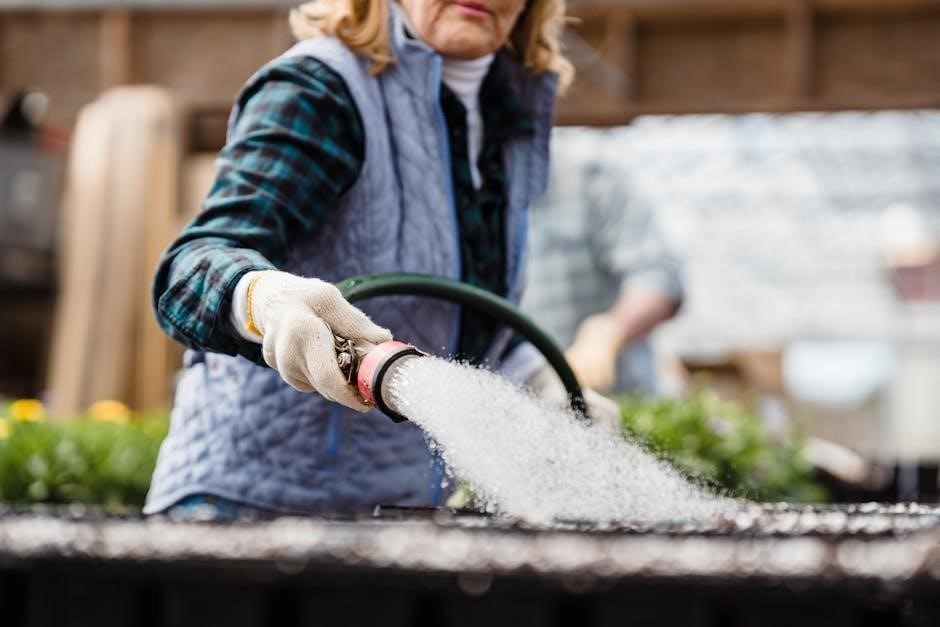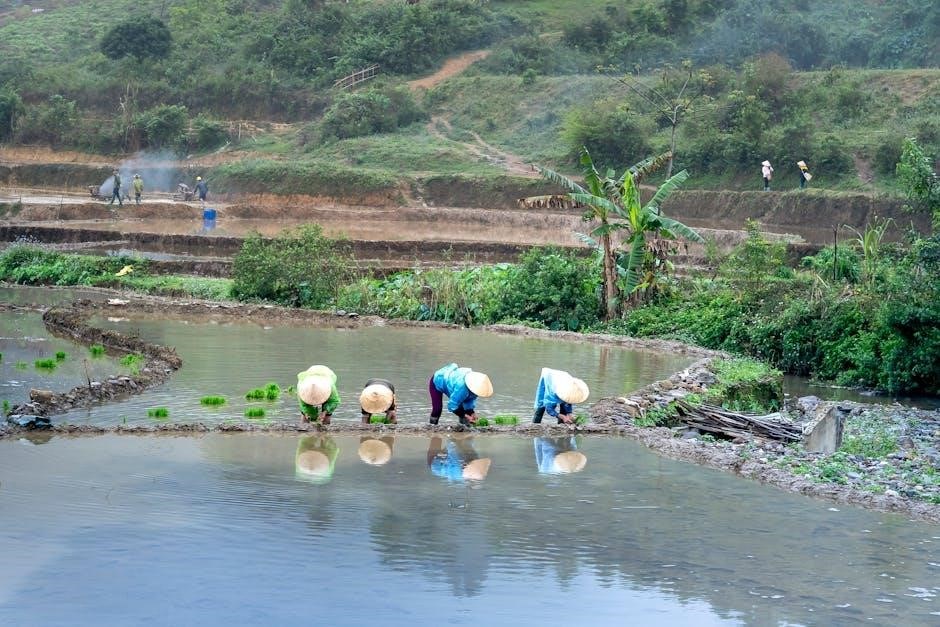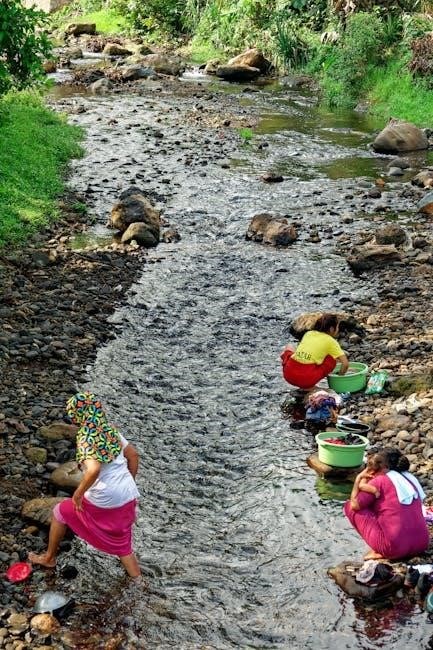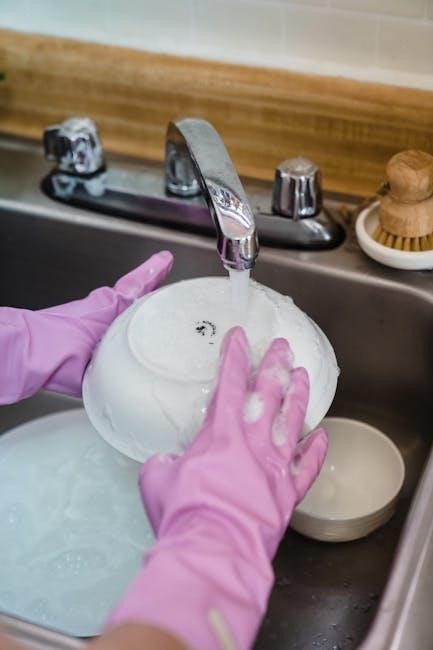Water heater manuals are essential guides providing detailed instructions for installation, maintenance, and troubleshooting. They ensure safe and efficient operation, covering topics like energy efficiency, capacity, and safety precautions. By following these manuals, users can optimize performance, reduce energy costs, and extend the lifespan of their water heaters. Whether for tankless, tank-style, or solar models, these resources are indispensable for both residential and commercial applications.
Importance of Water Heater Manuals
Water heater manuals are crucial for ensuring safe, efficient, and proper operation of water heating systems. They provide detailed instructions for installation, maintenance, and troubleshooting, helping users avoid costly mistakes. Manuals also outline safety precautions, such as electrical and gas guidelines, to prevent accidents. By following the manual, users can optimize energy efficiency, reduce operational costs, and extend the lifespan of their water heater. Additionally, manuals serve as a reference for understanding technical specifications, warranty information, and manufacturer recommendations, making them an indispensable resource for homeowners and professionals alike. They empower users to make informed decisions and resolve issues effectively.
What to Expect in a Water Heater Manual
A water heater manual typically includes comprehensive details about installation, operation, and maintenance. It covers technical specifications, such as capacity, fuel type, and energy efficiency ratings. Users can expect step-by-step installation guides, troubleshooting tips for common issues, and safety precautions to ensure proper use. Manuals also provide information on warranty terms, manufacturer recommendations, and parts diagrams; Additionally, they often include sections on energy-saving features and optimal usage practices. Brand-specific manuals, like those from Rheem or Kenmore, may offer tailored advice for specific models. Overall, the manual serves as a one-stop resource for understanding and managing your water heater effectively.

Types of Water Heaters
Water heaters vary by type, including tankless, tank-style, heat pump, and solar models. Each offers unique features, such as continuous hot water or energy efficiency, to suit different needs.
Tankless Water Heaters
Tankless Water Heaters
Tankless water heaters, also known as on-demand heaters, provide hot water only when needed, eliminating the need for a storage tank. They are highly energy-efficient and space-saving, making them ideal for small homes or apartments. These heaters typically require a power source and proper venting, with options for gas, electric, or propane models. Tankless systems often come with digital temperature controls, allowing precise adjustments. However, they may require additional installation steps, such as upgrading water lines or ensuring proper drainage. Regular maintenance, like cleaning filters and checking for mineral buildup, is essential for optimal performance and longevity. They are scalable to meet household needs.
Tank-Style Water Heaters
Tank-Style Water Heaters
Tank-style water heaters are the most common type, featuring an insulated tank that stores and heats water. They are available in various sizes, with capacities ranging from 30 to 100 gallons. These heaters use either electric, gas, or propane to heat the water, which is stored until needed. Tank-style heaters are relatively simple to install and maintain, with components like thermostats, temperature and pressure relief valves, and heating elements. They provide a ready supply of hot water but may have higher energy costs due to standby heat loss. Regular maintenance, such as checking for rust and sediment buildup, is crucial for extending their lifespan and efficiency.
Heat Pump Water Heaters
Heat pump water heaters are highly efficient systems that transfer heat from the surrounding air to the water, rather than generating heat directly. They are known for their energy efficiency, often achieving higher Energy Factor (EF) ratings than traditional electric or gas heaters. These heaters typically feature advanced components like compressors, evaporator coils, and refrigerant, requiring specific maintenance procedures. Regular filter cleaning and checks are essential to ensure optimal performance. Heat pump water heaters are environmentally friendly, reducing energy consumption and operating costs. They may qualify for rebates or incentives due to their efficiency. Installation requires proper space and ventilation for air circulation.
Solar Water Heaters
Solar water heaters harness solar energy to heat water, offering a sustainable and cost-effective solution. These systems typically include solar panels, a storage tank, and a circulation system. The manual provides detailed instructions for installation, emphasizing proper panel orientation and placement to maximize sunlight exposure. Maintenance tips include regular cleaning of panels, checking for leaks, and ensuring insulation of pipes. Solar water heaters are environmentally friendly, reducing reliance on fossil fuels. They may require backup systems for cloudy days or high-demand periods. Manuals often highlight local incentives or rebates for installing solar systems, making them a financially attractive option for homeowners.

Technical Specifications in Water Heater Manuals
Technical specifications provide key details like dimensions, weight, capacity, fuel type, energy efficiency, temperature range, and pressure limits. These details help users select the right model and ensure proper installation.
Dimensions and Weight
Dimensions and Weight
Dimensions and weight are critical specifications in water heater manuals, ensuring proper installation and space planning. These details include the unit’s height, width, and depth, as well as its weight in pounds or kilograms. Knowing these measurements helps users determine if the heater fits in the allocated space, such as a basement or utility closet. Weight is important for handling and transportation, especially for tank-style heaters, which can be heavier. Accurate dimensions also aid in venting and clearance requirements, ensuring safe and efficient operation. This information is vital for installers to plan and execute the setup correctly without spatial or logistical issues.
Capacity and Flow Rate
Capacity and Flow Rate
Capacity and flow rate are essential specifications in water heater manuals, determining the unit’s ability to meet hot water demands. Capacity, often measured in gallons, indicates the amount of hot water the heater can store or produce continuously. Flow rate, typically in gallons per minute (GPM), shows how much hot water can be delivered simultaneously to multiple fixtures like showers or sinks. These metrics help users choose a heater that matches their household needs, ensuring adequate supply without excess energy use. Manuals usually provide charts or tables detailing flow rates at various temperature settings, aiding in selecting the right model for specific water usage patterns.
Fuel Type and Energy Efficiency
Fuel Type and Energy Efficiency
Fuel type and energy efficiency are critical details in water heater manuals, helping users understand operational costs and environmental impact. Common fuel types include electricity, natural gas, propane, and solar energy. Manuals specify the type of fuel required and provide energy efficiency ratings, such as AFUE (Annual Fuel Utilization Efficiency) or EF (Energy Factor). Higher ratings indicate better efficiency, reducing energy consumption and lowering utility bills. Users should review these details to ensure compatibility with their home’s energy setup and to make informed decisions about long-term cost savings. This section also highlights features like eco-mode or smart sensors that enhance efficiency further.
Temperature Range and Pressure
Temperature Range and Pressure
Water heater manuals provide essential details about temperature range and pressure specifications to ensure safe and efficient operation. The manual outlines the recommended temperature settings, typically ranging from 100°F to 140°F, to prevent scalding and optimize energy use. Pressure specifications, including maximum allowable working pressure, are also included to avoid system damage. Users are advised to adjust settings according to their needs while adhering to safety guidelines. Proper pressure maintenance is crucial to prevent leaks or tank failure. The manual may also cover pressure relief valve installation and testing to ensure the system operates within safe limits for long-term reliability and performance.

Installation and Maintenance Guidelines
Proper installation and regular maintenance ensure efficiency, safety, and longevity. Follow manufacturer instructions, perform routine checks, and address wear and tear promptly to maintain optimal performance and safety.
Pre-Installation Checks
Pre-Installation Checks
Before installing your water heater, ensure the site meets all safety and compatibility requirements. Verify the location complies with local building codes, is well-ventilated, and has no flammable materials nearby. Check the heater’s dimensions to ensure proper fitment. Inspect the unit for damage during delivery. Review the manual to confirm all necessary tools and materials are available. Ensure the area is clear and accessible. Properly prepare the surface for installation, including drainage and electrical connections; Failure to perform these checks may lead to installation errors or safety hazards. Always follow the manual’s specific guidelines for a safe and successful setup.
Step-by-Step Installation Process
Step-by-Step Installation Process
Begin by connecting the water supply lines to the heater’s inlet and outlet ports, ensuring they are securely fastened. Next, attach the energy source, whether it’s electrical, gas, or solar connections, following the manual’s wiring or piping instructions. Install the temperature and pressure relief valve, making sure it is properly vented. Connect the drain pan and overflow pipe to prevent water damage. Secure the heater to the wall or floor to prevent tipping. Finally, test the system by turning on the power and checking for leaks. Ensure all connections are tight and the unit is level before completing the installation process.
Post-Installation Maintenance Tips
Post-Installation Maintenance Tips
After installation, regularly check the temperature and pressure relief valve to ensure it functions correctly. Insulate exposed pipes to reduce heat loss and energy consumption. Drain the tank annually to remove sediment buildup, which can improve efficiency. Adjust the thermostat to an optimal temperature (120°F recommended) to prevent overheating and save energy. Inspect for leaks around connections and address them promptly. Replace the anode rod every 3-5 years to prevent corrosion. Schedule annual professional inspections to maintain performance and safety. Keep the area around the heater clean and well-ventilated to ensure proper operation and longevity of the unit.

Troubleshooting Common Issues
This section guides users in identifying and resolving common water heater problems, such as no hot water, leaks, or unusual noises, with step-by-step solutions.
No Hot Water or Insufficient Hot Water
No Hot Water or Insufficient Hot Water
If your water heater isn’t producing enough hot water, check the thermostat setting to ensure it’s set correctly. Verify the power supply and circuit breaker to confirm the heater is operational. Inspect the heating elements or burner for damage or malfunction. Sediment buildup in the tank can reduce efficiency—flushing the tank may resolve the issue. Leaks or faulty temperature-pressure relief valves could also cause insufficient hot water. Refer to your manual for specific troubleshooting steps, such as resetting the heater or replacing faulty components; Ensuring proper maintenance and adjustments can restore adequate hot water supply efficiently and safely.
Leaks or Water Damage
Leaks or Water Damage
Leaks or water damage around your water heater can indicate serious issues. Check the temperature-pressure relief valve, inlet/outlet connections, and drain valve for any signs of moisture or dripping. Corrosion, loose fittings, or faulty gaskets are common causes. Inspect the tank for rust or cracks, as these can lead to leaks. If you notice water pooling, turn off the power and water supply immediately. Refer to your manual for guidance on tightening connections or replacing seals. Addressing leaks promptly prevents further damage and ensures safe operation. Regular inspections can help identify potential issues before they escalate, saving time and money.
Strange Noises or Odors
Strange Noises or Odors
Strange noises or unpleasant odors from your water heater can signal underlying problems; Rumbling, banging, or hissing sounds may indicate sediment buildup, loose pipes, or faulty heating elements. Odd odors, such as a rotten egg smell, often result from bacteria growth in the tank or sulfur compounds in the fuel. Refer to your manual to identify the cause and appropriate solutions. For noises, check for loose connections or sediment accumulation. For odors, flushing the tank or replacing the anode rod may resolve the issue. Addressing these problems promptly ensures optimal performance and prevents potential safety hazards.

Safety Precautions and Warnings
Always follow safety guidelines to prevent accidents. Ensure proper installation, ventilation, and regular maintenance. Be aware of temperature settings and potential hazards to guarantee safe operation.
Electrical Safety Guidelines
Electrical Safety Guidelines
When working with your water heater, always disconnect the power supply before performing maintenance or repairs. Ensure all electrical connections are secure and meet local codes. Avoid using extension cords, as they can overheat. Never attempt DIY electrical repairs unless you are qualified. Keep the area around the water heater dry to prevent electrical shocks. Install Ground Fault Circuit Interrupter (GFCI) outlets for added protection. Regularly inspect wires and components for damage or wear. Follow the manufacturer’s wiring diagram and guidelines to ensure safe electrical operation. Proper grounding is essential to prevent electrical hazards and ensure safe functioning of the unit.
Gas Safety Precautions
Gas Safety Precautions
Ensure proper ventilation in the installation area to prevent carbon monoxide buildup. Always check for gas leaks using a soapy water solution and tighten connections if bubbles form. Never use an open flame to detect leaks. Ensure the water heater is installed by a qualified professional following local codes and manufacturer guidelines. Regularly inspect the burner and venting system for blockages or damage. Only use approved replacement parts to maintain safety and performance. Keep the area clear of flammable materials. If you smell gas, turn off the supply immediately and contact a professional. Never attempt to repair gas lines or connections yourself.

Scalding Prevention Tips
Scalding Prevention Tips
To avoid scalding, set your water heater temperature to a maximum of 120°F (49°C). Install temperature mixing valves to regulate water flow and prevent extreme heat. Always test water temperature before use, especially for children, the elderly, or individuals with sensitive skin. Ensure all faucets have scald-resistant handles or anti-scald devices. Regularly inspect and maintain temperature-pressure relief valves to ensure they function correctly. Keep small children away from hot water sources and educate household members on safe water usage. Never leave unattended individuals, especially children, near running hot water. Adjusting these settings can significantly reduce the risk of burns.

Energy Efficiency and Cost Savings
Energy-efficient water heaters reduce energy consumption and lower utility bills; Modern models offer advanced features like timers and smart sensors to optimize performance and savings.
Understanding Energy Efficiency Ratings
Understanding Energy Efficiency Ratings
Energy efficiency ratings in water heater manuals provide crucial insights into a unit’s energy consumption and environmental impact. These ratings, often certified by organizations like ENERGY STAR, indicate how efficiently a water heater uses energy. Higher ratings typically mean lower energy consumption and reduced utility bills. The ratings are calculated based on factors like fuel type, insulation quality, and overall performance. By understanding these ratings, homeowners can make informed decisions about which water heater best fits their energy-saving goals and budget. Always refer to the manual for specific efficiency metrics and how they translate into cost savings over time.
Tips to Reduce Energy Consumption
Tips to Reduce Energy Consumption
Reducing energy consumption with your water heater starts with simple adjustments. Lowering the temperature setting to 120°F can save significant energy while still providing ample hot water. Insulating exposed pipes and the water heater itself reduces heat loss, especially in unheated areas. Installing a tankless water heater or a heat pump model can improve efficiency. Additionally, taking shorter showers and fixing leaks promptly conserve energy. Regularly maintaining your water heater by flushing sediment and checking the anode rod ensures it runs efficiently. These tips, outlined in your manual, help minimize energy usage and lower utility bills over time.
Cost-Saving Features in Modern Water Heaters
Cost-Saving Features in Modern Water Heaters
Modern water heaters often include advanced cost-saving features. Smart thermostats allow users to program temperature settings, optimizing energy use during off-peak hours. Eco-mode settings reduce standby heat loss, minimizing energy waste. High-efficiency models with improved insulation retain heat better, lowering operating costs. Some units feature self-cleaning capabilities to maintain efficiency over time. Additionally, tankless and heat pump water heaters, as highlighted in manuals, offer superior energy savings compared to traditional models. These innovations, detailed in your manual, help reduce utility bills and extend the lifespan of your water heater, providing long-term financial benefits and environmental advantages.

Popular Brands and Their Manuals
Leading brands like Rheem, Kenmore, State, and A.O. Smith provide comprehensive manuals. These guides include installation, troubleshooting, and maintenance tips specific to their models, ensuring optimal performance and longevity.
Rheem Water Heater Manuals
Rheem Water Heater Manuals
Rheem water heater manuals are detailed guides tailored to specific models, offering step-by-step instructions for installation, maintenance, and troubleshooting. They cover technical specifications, safety precautions, and energy efficiency features. Users can find diagnostic charts for error codes, parts lists, and warranty information. Rheem manuals emphasize proper installation to ensure optimal performance and longevity. They also provide tips for energy savings and water temperature adjustment. Digital versions are accessible online, making it easy to reference or print specific sections. By following these manuals, users can maximize their water heater’s efficiency and safety, ensuring reliable hot water supply for years.
Kenmore Water Heater Manuals
Kenmore Water Heater Manuals
Kenmore water heater manuals are essential resources for users, providing detailed information specific to each model. They include installation instructions, maintenance schedules, and troubleshooting guides to ensure optimal performance. The manuals cover technical specifications, safety precautions, and energy-saving tips. Kenmore manuals often feature diagrams and charts to help users understand complex processes. They also include warranty details and parts lists for easy reference. Available in digital formats, these manuals are easily accessible online, allowing users to print or save relevant sections. By following the guidelines, users can maintain their water heaters efficiently, ensuring safety, energy savings, and reliable hot water delivery.
State Water Heaters Manuals
State Water Heaters Manuals
State water heater manuals provide comprehensive guidance tailored to specific models, ensuring users can optimize performance and troubleshoot effectively. These manuals detail installation requirements, maintenance routines, and technical specifications to help users understand their units better. They often include energy efficiency tips and safety guidelines to promote responsible usage. State manuals are known for their clear diagrams and step-by-step instructions, making complex tasks manageable. Additionally, they cover warranty information and parts replacement procedures, offering long-term support. By adhering to the manual’s recommendations, users can extend the lifespan of their water heaters while maintaining safety and efficiency.
A.O. Smith Water Heater Manuals
A.O. Smith Water Heater Manuals
A.O. Smith water heater manuals are detailed resources designed to help users operate, maintain, and troubleshoot their units effectively. These manuals provide model-specific information, including installation instructions, technical specifications, and energy efficiency ratings. They often feature diagrams and charts to clarify complex procedures, such as temperature adjustments and parts replacement. A.O. Smith manuals also emphasize safety precautions and offer tips for optimizing performance. With a focus on user-friendly language, they ensure that both professionals and homeowners can make the most of their water heaters. Additionally, the manuals include warranty details and contact information for customer support, making them indispensable for long-term use.

Best Practices for Using Water Heater Manuals
Always read the manual before installation and operation. Follow manufacturer guidelines for maintenance and troubleshooting. Refer to it regularly for optimal performance and safety. Keep it handy for future reference and updates.
Reading the Manual Before Use
Reading the Manual Before Use
Reading the water heater manual before use is essential for safe and efficient operation. It provides critical information about installation, operation, and maintenance. Understanding the manual ensures proper setup, avoiding potential hazards like scalding or gas leaks. Familiarize yourself with safety precautions, control settings, and emergency shutdown procedures. The manual outlines energy-saving features and optimal temperature settings. It also guides troubleshooting common issues, reducing downtime and extending lifespan. By reading the manual, you can avoid costly mistakes and ensure compliance with manufacturer recommendations, preserving warranty validity. Take time to review it thoroughly to maximize performance and safety.
Keeping the Manual for Future Reference
Keeping the Manual for Future Reference
Keeping the water heater manual for future reference is crucial for long-term maintenance and troubleshooting. Over time, you may need to refer back to installation instructions, warranty details, or specific maintenance schedules. Storing the manual in an accessible location ensures you can quickly address issues without searching online. It also serves as a valuable resource for understanding error codes, diagnosing problems, and performing routine checks. Additionally, the manual provides essential information for future repairs or upgrades, helping you avoid costly service calls. Store it digitally or in a safe place to ensure it remains available when needed.
Updating Your Knowledge with New Manuals
Updating Your Knowledge with New Manuals
Updating your knowledge with new water heater manuals ensures you stay informed about the latest features, safety guidelines, and technological advancements. Manufacturers often release updated manuals to reflect improvements, new models, or changes in regulations. Regularly reviewing these documents helps you understand enhanced functionality, energy-saving tips, and maintenance recommendations tailored to your specific unit. This proactive approach enables you to optimize performance, troubleshoot more effectively, and take advantage of new features. Additionally, updated manuals may include corrected instructions or expanded troubleshooting sections, ensuring you have the most accurate and comprehensive information to manage your water heater effectively over time.